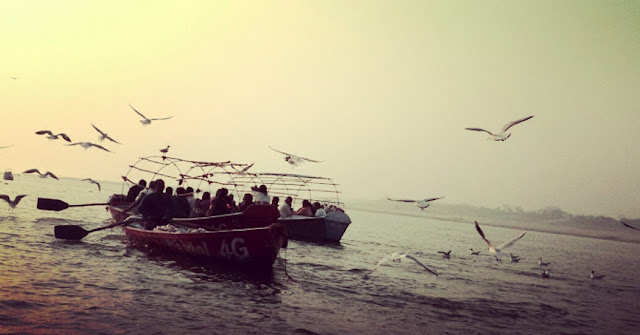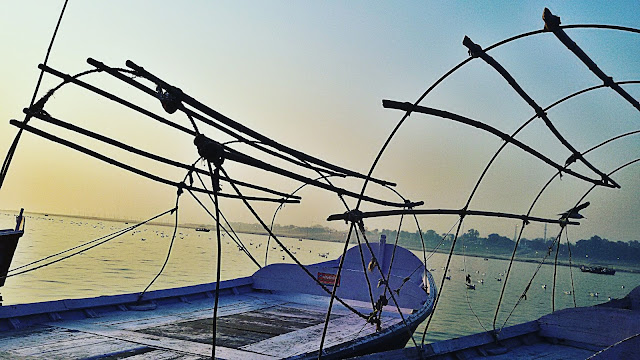Triveni Sangam is the confluence of
three rivers: Ganga, Yamuna and the mythical Saraswati. The point of confluence
is a sacrosanct place for Hindus. As Ganga makes her way from Gangotri to the
Bay of Bengal travelling through places made sacred by her (Haridwar,
Rishikesh,and Kanpur); she meets Yamuna at Sangam, Allahabad before advancing
to Varanasi.
 |
| Triveni Sangam |
In the pre-historic times, River Saraswati was believed to
have flown and met with Ganga and Yamuna – which still stays as the confluence,
Triveni Sangam in Allahabad. The diverse stages in the northwest movement of
River Saraswati get extensively reflected in the Vedas and other ancient
manuscripts. According to Hinduism, the early stages concur with the depiction
in Rigveda, the middle stages with the Yajurveda and Atharvaveda while
the last stages coincide with the epic, Mahabharata.
According to Hindu Mythology, it is
believed that a bath taken at Triveni Sangam washes away all the sins and frees
one from the cycle of rebirth. Prayag is a critical and indispensable part of
the Ganga Yamuna Doab, and its history is intrinsically tied with that of the
Doab region. The Doab was controlled by many dynasties. The region was a part
of the great Mauryan and Gupta Empires from the east and the Kushan Empire from
the west before being administered by Kannauj in the fifteenth century. The
city was the site of Maratha invasions before India was colonized.
In the Mughal era, Allahabad was a
provincial capital under the rule of Jahangir. Emperor Akbar had made it the
seat of Illahabad Subah (one of his twelve majestic provinces of significance),
assembled a stronghold on the banks of the sangam and renamed the settlement Ilāhābād.
The rivers are unmistakably different
at the confluence. The turbid and pale yellow water of the Ganga mixes with the
bluish green colour water of the Yamuna, bringing about a breathtaking view.
The boats cost as high as three thousand rupees and can be as low as five
hundred rupees. Added to that, the rowers and the priests request some extra
tips. Tourists and devotees must be prepared to wrangle a considerable amount.
At the confluence, the Ganges is just 4 feet deep,while the Yamuna is 40 feet deep.
During Kumbh Mela, Sangam exhibits an out and out amazing look and feel. Millions of devotees come there to take a bath at Sangam. It is believed that the purification by bathing at Sangam increases by 100 times, while bathing during Kumbh Mela increases it by 1000 times.
At the confluence, the Ganges is just 4 feet deep,while the Yamuna is 40 feet deep.
During Kumbh Mela, Sangam exhibits an out and out amazing look and feel. Millions of devotees come there to take a bath at Sangam. It is believed that the purification by bathing at Sangam increases by 100 times, while bathing during Kumbh Mela increases it by 1000 times.
A lot of hotels are available near Sangam Triveni. Some of the
best places to visit nearby are the Allahabad fort, Bade Hanuman Jee Temple,
Anand Bhavan, All Saints Cathedral and the Company Gardens of Allahabad.
Tourists and devotees can see a lot of local shops selling
bangles and beaded accessories for women.
During winters, the Siberian migratory birds take off from
Siberia to India. These birds travel from Siberia, travel through Afghanistan
and Central Asia and arrive at the birds' Sanctuary at Bharatpur. Sangam is one
of the wetlands viewed as one of the breeding places of these birds.
 |
| Siberian Migratory Birds |










Comments
Post a Comment